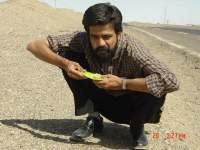- Forum
- categories
- Resource recovery
- Greywater, blackwater or wastewater reuse, irrigation
- Blue green algae in treated wastewater and lakes (city of Bengaluru, India)
Blue green algae in treated wastewater and lakes (city of Bengaluru, India)
19.2k views
- Heiner
-

- I am a retired organic farmer and interested in nutrient cycles. As an volunteer I now travel mainly to poor countries and together with locals I would like to find new ways of sustainable agriculture. This is beyond the regulations of IFOAM.
Less- Posts: 80
- Karma: 1
- Likes received: 67
Dear all,
"Oh, if farmers want to use the water for irrigation then they might be disappointed if you lower the nitrogen and phosphorus levels as it's a fertiliser to them"
As a farmer I agree 100%, Elisabeth. And this would counteract our efforts to close the loop all over the world.
But the engineers over there must have had any ideas when they created the lakes. Upcoming algae do not really surprise, I guess??
As an ordinary farmer (no scientist) I would throw some water hyacinth into the water of one lake and see what happens. If you are lucky they clean the water, suppress the algae and you can harvest them as green manure (dried or composting after semi dry).
Hope someone tells me why this wouldn't work, just to increase my knowledge....
Have a nice day,
Heiner
"Oh, if farmers want to use the water for irrigation then they might be disappointed if you lower the nitrogen and phosphorus levels as it's a fertiliser to them"
As a farmer I agree 100%, Elisabeth. And this would counteract our efforts to close the loop all over the world.
But the engineers over there must have had any ideas when they created the lakes. Upcoming algae do not really surprise, I guess??
As an ordinary farmer (no scientist) I would throw some water hyacinth into the water of one lake and see what happens. If you are lucky they clean the water, suppress the algae and you can harvest them as green manure (dried or composting after semi dry).
Hope someone tells me why this wouldn't work, just to increase my knowledge....
Have a nice day,
Heiner
Heiner, the old farmer.....
Please Log in to join the conversation.
You need to login to reply- Elisabeth
-
- User is blocked
- Freelance consultant since 2012
Less- Posts: 3372
- Karma: 54
- Likes received: 932
Re: Blue green algae in treated wastewater
Dear Vishwanath,
This is "easy" to solve if the money is available: You need to add another stage to your wastewater treatment plants called Biological Nutrient Removal (BNR, see here for an intro: en.wikipedia.org/wiki/Sewage_treatment#B...cal_nutrient_removal).
Many other cities have had to do that, too, e.g. here in Brisbane, Australia, where there was problems with water quality in Moreton Bay.
It is a proven process but it does add costs to your capital and O&M expenses.
Another thing do look out for is nutrient run off from agricultural practices (excessive fertiliser use). Also stormwater overflows could be an issue.
Oh, if farmers want to use the water for irrigation then they might be disappointed if you lower the nitrogen and phosphorus levels as it's a fertiliser to them. So you need to carefully assess the situation... Maybe the farmers could draw directly from the effluent channel of the wastewater treatment plant, rather than from the lakes? I guess that it tricky because of the distances involved. Hmmmm.....
Elisabeth
This is "easy" to solve if the money is available: You need to add another stage to your wastewater treatment plants called Biological Nutrient Removal (BNR, see here for an intro: en.wikipedia.org/wiki/Sewage_treatment#B...cal_nutrient_removal).
Many other cities have had to do that, too, e.g. here in Brisbane, Australia, where there was problems with water quality in Moreton Bay.
It is a proven process but it does add costs to your capital and O&M expenses.
Another thing do look out for is nutrient run off from agricultural practices (excessive fertiliser use). Also stormwater overflows could be an issue.
Oh, if farmers want to use the water for irrigation then they might be disappointed if you lower the nitrogen and phosphorus levels as it's a fertiliser to them. So you need to carefully assess the situation... Maybe the farmers could draw directly from the effluent channel of the wastewater treatment plant, rather than from the lakes? I guess that it tricky because of the distances involved. Hmmmm.....
Elisabeth
Dr. Elisabeth von Muench
Freelance consultant on environmental and climate projects
Freelance consultant on environmental and climate projects
Please Log in to join the conversation.
You need to login to reply- Vishwanath
-
 Topic AuthorLess
Topic AuthorLess- Posts: 6
- Karma: 1
- Likes received: 4
In the state of Karnataka, India , specifically in the city of Bengaluru one of the worlds largest treated wastewater project for irrigation use is being run. 770 million litres per day of treated wastewater is being pumped to fill around 300 lakes in the surrounding districts which are drought prone. The waters will fill lakes upto a 120 km away.
The project is already under way and the water has started reaching the lakes. These waters are then allowed to recharge into the aquifers and then will be used by farmers for irrigation purpose.
There is a problem however with blue green algae blooms in some of these lakes , thanks to the Nitrates and Phosphates present in the waters.
How can the blue green algae blooms be reduced or eliminated ?
The project is already under way and the water has started reaching the lakes. These waters are then allowed to recharge into the aquifers and then will be used by farmers for irrigation purpose.
There is a problem however with blue green algae blooms in some of these lakes , thanks to the Nitrates and Phosphates present in the waters.
How can the blue green algae blooms be reduced or eliminated ?
Please Log in to join the conversation.
You need to login to reply
Share this thread:
- Forum
- categories
- Resource recovery
- Greywater, blackwater or wastewater reuse, irrigation
- Blue green algae in treated wastewater and lakes (city of Bengaluru, India)
Recently active users. Who else has been active?
Time to create page: 0.109 seconds







